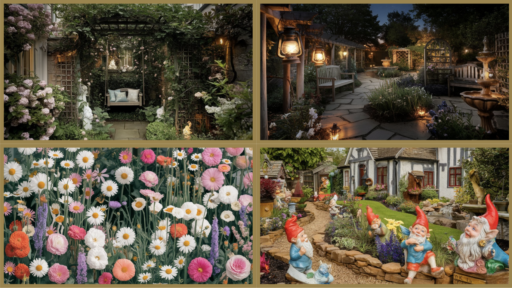After years of designing gardens, I’ve realized there’s nothing quite like the charm of an English garden.
The mix of winding paths, blooming flowers, and cozy nooks creates a space that feels straight out of a storybook.
I love how these gardens embrace a sense of wildness while still feeling carefully curated—perfect for relaxing or entertaining.
Let me share how you can transform your outdoor space into an enchanting English garden.
Whether working with a sprawling yard or a compact corner, these ideas will help create a timeless and beautiful retreat.
Unique English Garden Ideas
1. Lush Flower Borders

One of my favorite ways to bring an English garden to life is by creating lush flower borders.
These blooms frame the garden beautifully and make the entire space feel vibrant and welcoming.
I love combining traditional English flowers like roses, foxgloves, and delphiniums to achieve that layered, colorful look.
The key is to plant taller flowers in the back and shorter ones in the front. This creates depth and allows every bloom to shine.
Mixing perennial plants for structure and annuals for seasonal color ensures the border looks full year-round.
Steps to Create:
- Prepare your soil by loosening it and adding compost.
- Plan your layout based on plant height and color harmony.
- Plant in layers, starting with taller varieties at the back.
- Add mulch to retain moisture and reduce weeds.
2. Cozy Garden Pathways

I’ve found that winding pathways are essential to capturing the charm of an English garden.
Something is enchanting about walking along a gravel or cobblestone path surrounded by greenery and flowers. Pathways guide the eye through the garden and create a sense of adventure.
I prefer natural materials like gravel, bricks, or cobblestones because they blend seamlessly with the plants. Lining the paths with low-growing flowers or herbs, such as thyme or lavender, adds an extra layer of beauty.
Curving the path instead of keeping it straight makes the space feel larger and more intriguing.
Steps to Create:
- Outline your path with string or garden stakes.
- Clear the area of grass and level the ground.
- Lay a base layer of crushed stone or sand for stability.
- Add your chosen material and compact it firmly.
3. Fragrant Herb Gardens
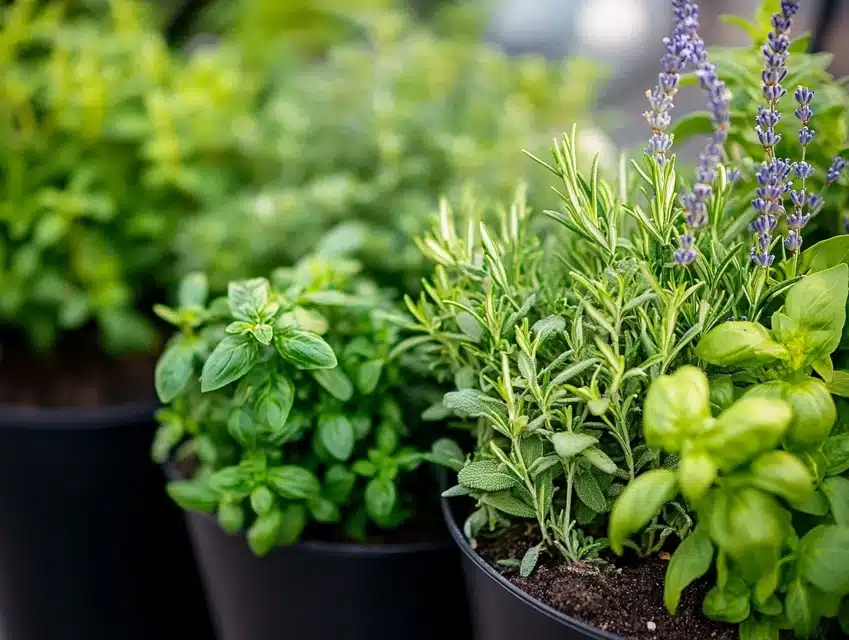
I always include an herb garden when designing an English garden because it is both beautiful and practical.
There’s nothing like the fresh scent of rosemary, thyme, or lavender drifting through the air as you walk through your garden. It’s a simple way to make your space feel alive and relaxing.
I usually plant herbs in neat rows or clusters to give the garden a classic look.
Mixing culinary herbs with fragrant ones ensures the garden is functional and decorative. I like to place herb gardens near pathways or seating areas for easy access.
Steps to Create:
- Choose a sunny spot with good drainage.
- Prepare the soil by mixing in compost or sand.
- Plant herbs in clusters or rows for a tidy appearance.
- Water consistently and prune regularly for healthy growth.
4. Hidden Seating Nooks

A hidden seating nook is one of the most delightful features of an English garden.
I’ve transformed many gardens by adding a quiet, cozy corner where you can sit back and enjoy the beauty. There’s something magical about having a private space surrounded by greenery.
I recommend framing the nook with tall shrubs or climbing plants like wisteria or jasmine. A simple wooden bench or wrought-iron chair works beautifully in these settings.
Adding cushions and potted plants creates a comfortable and inviting atmosphere, perfect for relaxing or reading a book.
Steps to Create:
- Select a partially shaded or secluded spot in the garden.
- Define the area with trellises, shrubs, or tall plants.
- Add a bench or chairs positioned for the best view.
- Decorate with potted plants, cushions, or a small table.
5. Colorful Cottage Borders

I love how colorful cottage borders bring a whimsical charm to an English garden.
These borders are filled with abundant flowers in various colors, heights, and textures, creating a natural yet intentional look. Adding flowers like daisies, peonies, and snapdragons captures the traditional cottage feel.
The beauty of these borders is their informal arrangement, which makes them look lush and effortless. I like to mix vibrant colors with soft pastels to keep the garden cheerful and balanced.
The layered effect of taller flowers in the back and shorter ones in the front completes the look.
Steps to Create:
- Loosen the soil and enrich it with compost.
- Arrange flowers by height and color before planting.
- Plant densely to create a full, abundant border.
- Add mulch to retain moisture and suppress weeds.
6. Climbing Rose Trellises

Climbing rose trellises are one of my favorite elements for adding height and romance to an English garden.
There’s something magical about seeing roses cascade over a trellis or archway, creating a picture-perfect entrance or focal point. I often use varieties like ‘New Dawn’ or ‘Eden’ for their profuse blooms.
I suggest positioning the trellis where it can frame a path or seating area. Climbing roses need proper support and regular training to grow in the desired direction.
Their rich colors and sweet fragrances make them stand out in any garden.
Steps to Create:
- Install a sturdy trellis or archway.
- Plant climbing roses at the base and tie the initial stems loosely to the structure.
- Train new growth to weave through the trellis.
- Prune regularly to encourage blooms and shape.
7. Reflective Water Features

Adding a reflective water feature brings tranquility and elegance to an English garden.
A small pond or a classic stone fountain enhances the garden’s atmosphere, making it feel serene and timeless. The gentle sound of water can also create a soothing background.
Positioning the water feature where it reflects nearby plants or flowers amplifies its beauty.
I like surrounding the area with shade-loving plants like ferns and hostas to create a natural setting.
Water adds a unique element to the space, whether it’s a simple birdbath or a more elaborate pond.
Steps to Create:
- Choose a level spot in the garden for your feature.
- Install a liner or foundation for a pond or fountain.
- Surround the area with plants or stones for a natural look.
- Maintain water cleanliness to prevent algae buildup.
8. Seasonal Flowerbeds

Seasonal flowerbeds are a great way to keep your garden fresh and colorful throughout the year.
I always recommend planting a mix of spring bulbs, summer perennials and fall flowers to ensure continuous blooms. This approach adds dynamic beauty to your garden.
I love using tulips and daffodils for spring, while summer calls for hydrangeas and zinnias.
In fall, chrysanthemums and asters provide vibrant bursts of color.
You can enjoy a garden that evolves with the seasons and feels alive year-round by rotating blooms.
Steps to Create:
- Plan your flowerbeds based on seasonal bloom times.
- Prepare the soil by removing weeds and adding compost.
- Plant bulbs or seeds according to their growing schedules.
- Deadhead flowers to promote continuous blooming.
9. Wisteria-Covered Archways

One of my favorite ways to add drama and elegance to an English garden is wisteria-covered archways.
These stunning climbers create a magical canopy of cascading blooms in purple, blue, or white shades. I love how they transform simple paths into dreamy garden entrances.
Wisteria thrives with proper support and regular pruning to keep it neat and blooming beautifully. Placing an archway in a central location or at an entry point ensures it becomes a standout feature.
The fragrance of wisteria adds an extra layer of sensory charm to the space.
Steps to Create:
- Install a sturdy archway or pergola.
- Plant wisteria at the base and train it onto the structure.
- Prune frequently to encourage flowering and control growth.
- Water regularly and apply fertilizer during the growing season.
10. Garden Ponds with Lily Pads

I’ve always found garden ponds to be a peaceful addition to an English garden, and adding lily pads enhances their natural beauty.
A small pond with floating lilies creates a tranquil focal point, attracting birds and frogs. The water’s soft reflections add to the garden’s serene feel.
Position the pond in a sunny area to ensure lilies bloom properly. For a natural finish, I like to surround the edges with rocks and water-friendly plants like irises.
A pond like this adds both visual interest and biodiversity to your garden.
Steps to Create:
- Dig and line a pond in a sunny spot.
- Add water and allow it to settle before introducing plants.
- Plant water lilies and aquatic plants in submerged containers.
- Install a small pump or aerator to maintain water quality.
11. Traditional Boxwood Hedges

Boxwood hedges are a timeless feature of English gardens. I love how their crisp, green shapes create structure and define different areas.
Whether used as borders, maze-like paths, or a backdrop for flower beds, these hedges add a polished touch.
Regular pruning keeps the hedges neat and allows you to shape them creatively. Boxwood is a versatile plant that pairs beautifully with flowers and other shrubs.
It’s an ideal way to bring a sense of order to the garden while maintaining its natural charm.
Steps to Create:
- Prepare well-draining soil for planting.
- Space boxwood plants evenly to allow for growth.
- Trim regularly to maintain shape and size.
- Mulch around the base to retain moisture and reduce weeds.
12. Wildflower Meadows

Creating a wildflower meadow in your garden brings a touch of countryside charm.
I love how these spaces burst with natural beauty, filled with daisies, cornflowers, and poppies swaying in the breeze.
A wildflower meadow is perfect for attracting bees, butterflies, and other pollinators.
These meadows thrive in sunny areas with low-maintenance soil. For a more authentic look, I often suggest mixing seeds of native flowers.
The meadow’s informal style contrasts beautifully with the garden’s structured elements, creating a harmonious balance.
Steps to Create:
- Clear the area of grass and weeds.
- Scatter a mix of wildflower seeds evenly.
- Water lightly to encourage germination.
- Avoid over-maintaining to preserve the natural look.
13. Brick Patio Seating Areas
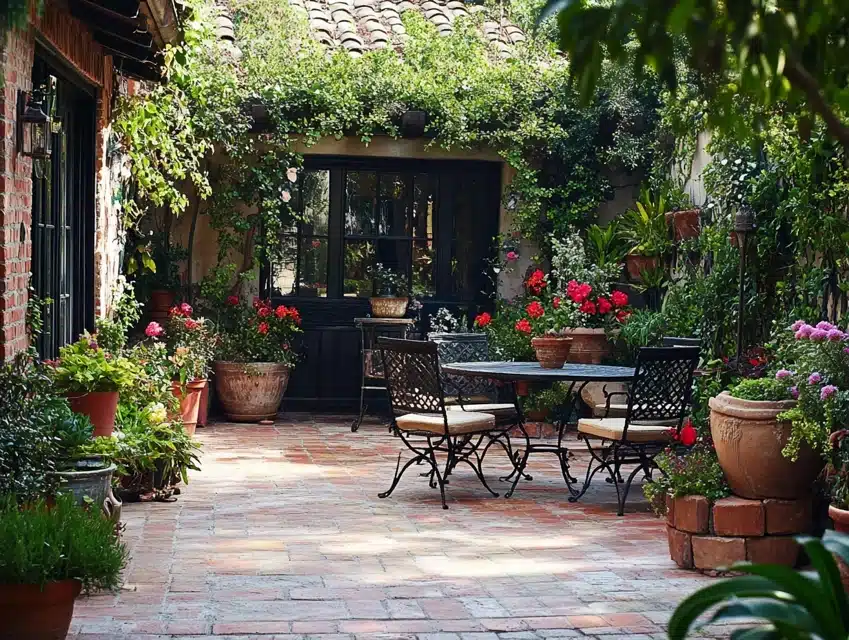
A brick patio is a classic feature that adds warmth and charm to an English garden.
I enjoy how the rustic texture of bricks complements the greenery and flowers, creating a cozy space for outdoor seating.
It’s perfect for entertaining guests or enjoying a quiet moment with a cup of tea.
To enhance the patio, I like to surround it with potted plants or climbing flowers for a seamless connection to the garden.
Adding vintage-style furniture like wrought iron chairs or wooden benches completes the look, making the space functional and inviting.
Steps to Create:
- Clear and level the area where the patio will be installed.
- Lay a layer of sand or crushed stone for stability.
- Arrange bricks in your chosen pattern, ensuring tight fits.
- Add a layer of sand over the bricks and sweep it into gaps for a finished look.
14. Flowering Shrub Borders

Flowering shrub borders are a wonderful way to add color, height, and structure to your garden.
To create these beautiful edges, I often use shrubs like hydrangeas, camellias, and lilacs. They provide seasonal blooms and make excellent backdrops for smaller flowers.
What I love most about shrub borders is their versatility—they can frame a pathway, define a seating area, or even act as privacy screens.
Their lush foliage ensures the garden looks vibrant even when not fully blooming, making them an asset year-round.
Steps to Create:
- Prepare the soil by loosening and enriching it with compost.
- Choose shrubs that bloom in different seasons for continuous interest.
- Space the plants according to their mature size.
- Water deeply after planting and mulch to retain moisture.
15. Rustic Garden Arbors

Adding a rustic garden arbor is one of my favorite ways to create vertical interest and define spaces.
Whether draped with climbing roses, clematis, or honeysuckle, an arbor brings an elegant yet natural charm to any English garden.
I like placing arbors at the entrance of a garden path or as a centerpiece in a seating area.
Their structure draws the eye upward, adding dimension and height to the space.
Using natural materials like wood or wrought iron enhances their traditional appeal.
Steps to Create:
- Install the arbor securely in the desired spot.
- Plant climbing vines at the base and train them to grow upward.
- Prune regularly to maintain neatness and encourage blooms.
- Decorate with fairy lights or lanterns for evening ambiance.
16. Gravel Pathways
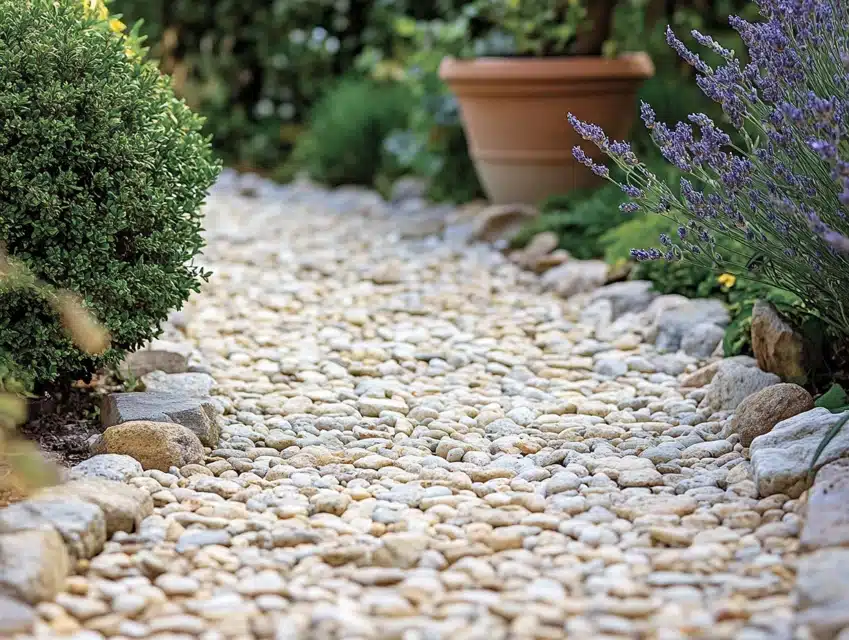
Gravel pathways are a simple yet effective way to add texture and movement to an English garden.
Their natural appearance pairs beautifully with lush greenery and blooming flowers, creating a timeless, inviting look.
Gravel paths are easy to install and maintain, making them a practical choice for any garden size.
I recommend lining the pathways with low-growing plants like lavender or thyme for added charm. The crunch of gravel underfoot adds a sensory experience that feels uniquely English.
Steps to Create:
- Map out the pathway and mark its edges with stakes or string.
- Excavate a shallow trench and lay a weed barrier.
- Fill the trench with crushed stone and level it.
- Add a layer of gravel and compact it for stability.
17. Cottage-Style Window Boxes

I love how cottage-style window boxes instantly add charm and character to an English garden. Filled with flowers like geraniums, petunias, or pansies, they bring splashes of color to walls, fences, or windows.
These boxes are perfect for small spaces where planting options might be limited.
The best part is that window boxes are versatile—you can change the flowers seasonally for a fresh look year-round.
Placing them at different heights or on multiple windows creates a layered effect, adding visual interest to the garden.
Steps to Create:
- Choose sturdy, weatherproof boxes that match your garden’s aesthetic.
- Fill with nutrient-rich soil and arrange flowers for color balance.
- Secure the boxes to walls or railings with brackets.
- Water regularly and deadhead flowers to encourage continuous blooming.
18. Sun-Dappled Pergolas

A pergola is one of my favorite features for adding structure and shade to an English garden.
Draped with climbing plants like roses or jasmine, it creates a cozy, sun-dappled seating area perfect for relaxing on warm afternoons.
I like placing pergolas over patios or walkways to define spaces while blending seamlessly with the surrounding garden.
Adding string lights or lanterns enhances the atmosphere, making it just as inviting during the evening.
Steps to Create:
- Install the pergola securely, ensuring proper anchoring.
- Plant climbing vines at the base and train them onto the structure.
- Add furniture or seating underneath for functionality.
- Decorate with soft lighting for added charm.
19. Topiary Features

Topiary is a classic element of English gardens that I find fun and elegant. Shaped shrubs add personality and structure, transforming your garden into a refined yet playful space.
Depending on your style, you can create simple spheres, spirals, or even intricate animal shapes.
Topiary works best near pathways, seating areas, or as focal points in flowerbeds. I recommend starting with small, manageable shapes if you’re new to pruning.
The clean lines and symmetry of the topiary balance the garden’s natural elements beautifully.
Steps to Create:
- Choose evergreen shrubs like boxwood or yew for shaping.
- Use shears or topiary forms to guide the pruning process.
- Trim regularly to maintain the desired shape.
- Place topiary strategically for maximum visual impact.
20. Seasonal Wildflower Beds
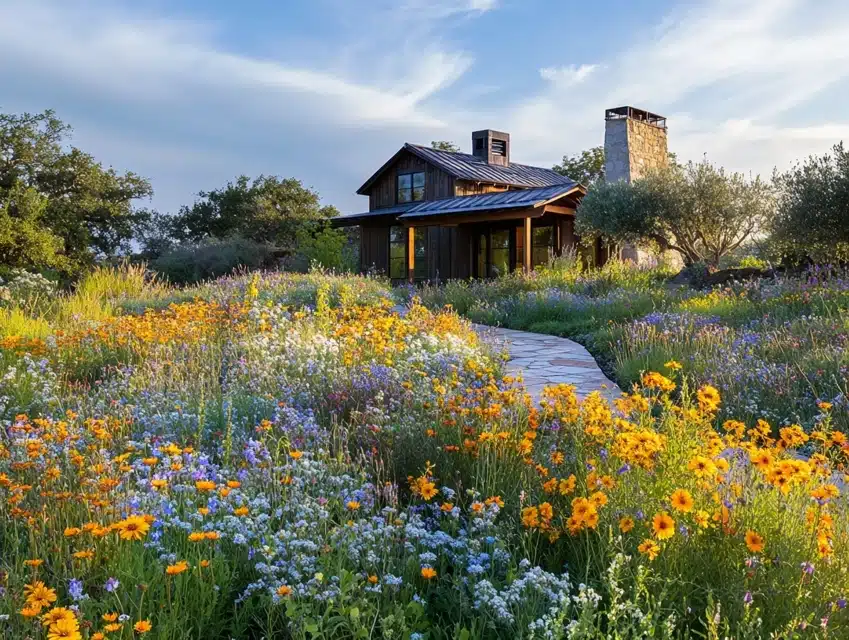
Seasonal wildflower beds are one of my favorite ways to keep an English garden lively and ever-changing.
I love how they add bursts of color throughout the year while supporting local pollinators like bees and butterflies. Mixing native flowers with traditional English blooms creates a harmonious blend.
These beds work well along pathways, borders, or in open spaces. By planning for spring, summer, and fall blooms, you can enjoy a vibrant garden year-round.
They’re also low-maintenance, which is a bonus for busy gardeners.
Steps to Create:
- Clear and prepare the soil, removing any weeds.
- Scatter a mix of wildflower seeds suited for your climate.
- Water gently to encourage germination.
- Thin out seedlings if necessary to prevent overcrowding.
21. Lavender-Lined Walkways

Lavender-lined walkways are one of my go-to ideas for creating a peaceful, aromatic atmosphere in an English garden.
I love how the soft purple blooms frame paths beautifully, filling the air with their calming scent. Lavender’s neat growth habit and long blooming season make it ideal for garden edges.
The key to success is planting lavender in well-draining soil and spacing it evenly to allow air circulation.
As the plants mature, they’ll form a natural hedge, adding structure and elegance to your walkways. This simple addition has a big impact.
Steps to Create:
- Prepare the edges of your walkway by loosening the soil.
- Space lavender plants about 12-18 inches apart.
- Plant in full sun and water deeply but infrequently.
- Prune lightly after flowering to maintain shape.
22. Rose-Covered Fences

One of my favorite ways to add romance to an English garden is to transform a simple fence into a feature with climbing roses.
The cascading blooms soften hard edges, creating a dreamy backdrop for other garden elements. I like using varieties like ‘Climbing Iceberg’ or ‘Zephirine Drouhin’ for their prolific flowering.
I’ve found that pairing rose-covered fences with flower borders or herb gardens enhances the overall charm.
Proper training and pruning ensure that the roses grow evenly and bloom abundantly. It’s a classic look that never goes out of style.
Steps to Create:
- Securely attach trellises or wires to your fence for support.
- Plant climbing roses at the base, spacing them appropriately.
- Tie the stems loosely to the supports as they grow.
- Prune and fertilize regularly for healthy blooms.
23. Secret Garden Gate

A secret garden gate is a whimsical feature that I love adding to English gardens.
There’s something magical about a wooden or wrought-iron gate framed by climbing plants or hedges. It creates a mystery, inviting you to explore what lies beyond.
I often place gates between two distinct garden sections or as an entryway to a hidden seating area.
Surrounding the gate with roses, ivy, or clematis adds to its enchanting appeal. This feature enhances the garden’s charm and helps define spaces.
Steps to Create:
- Install a sturdy gate that suits your garden’s aesthetic.
- Frame the gate with climbing plants or shrubs.
- Add stepping stones or a path leading up to the gate.
- Regularly prune surrounding plants to keep the entrance accessible.
24. Bee-Friendly Flower Zones

Bee-friendly flower zones are a wonderful way to bring life and movement to an English garden while supporting pollinators.
I enjoy selecting flowers like foxgloves, sunflowers, and lavender that attract bees and butterflies. Watching them flit around the garden adds a lively, natural touch.
These zones work best in sunny areas, and for a cohesive look, I often plant them near herb gardens or wildflower meadows.
Creating small clusters of flowering plants ensures a continuous supply of nectar throughout the seasons, making the garden both beautiful and beneficial.
Steps to Create:
- Select a sunny spot with good drainage.
- Plant a mix of nectar-rich flowers in clusters.
- Avoid using pesticides to keep the area safe for pollinators.
- Deadhead flowers to encourage continuous blooming.
25. Hydrangea Highlights

Hydrangeas are one of my favorite plants for creating a lush, colorful focal point in an English garden.
Their large, vibrant blooms add drama and elegance to any space. Depending on the soil pH, they come in shades of pink, blue, white, and even green.
Hydrangeas work beautifully in borders, around seating areas, or as standalone features.
Plant them in well-draining soil to keep them thriving and provide morning sun with afternoon shade. Their abundant blooms make the garden feel full and inviting.
Steps to Create:
- Choose a partially shaded location with rich, moist soil.
- Depending on the variety, space plants are about 3-5 feet apart.
- Water deeply and regularly, especially during dry spells.
- Prune lightly to shape and remove dead blooms after flowering.
26. White Garden Corners

I love the serene elegance of a white garden corner.
This monochromatic design uses white flowers like lilies, peonies, and snowdrops to create a peaceful and calming space. Adding white flowering shrubs or climbing roses enhances the sense of purity and timelessness.
These corners are perfect for a seating area or a reflective nook within your garden.
Pairing the white blooms with green foliage creates a striking contrast that feels effortless and refreshing. It’s a great way to add sophistication without overwhelming the senses.
Steps to Create:
- Select a shaded or semi-sunny corner for planting.
- Use a mix of white flowers, shrubs, and climbers for variety.
- Incorporate seating or a small water feature for added tranquility.
- Maintain regularly by deadheading and pruning plants.
27. Mixed Perennial Borders

Mixed perennial borders are my go-to solution for adding year-round interest to an English garden.
Combining flowers like delphiniums, irises, and coreopsis creates a border that evolves with the seasons, ensuring there’s always something blooming.
I like arranging taller plants at the back and shorter ones in the front for a layered effect.
Mixing perennials with varying bloom times keeps the garden vibrant throughout the year. These borders are ideal for framing pathways, patios, or fencing.
Steps to Create:
- Prepare the soil by enriching it with compost.
- Plan the arrangement based on plant height and bloom times.
- Plant perennials in clusters for a natural, cohesive look.
- Mulch and water regularly to promote healthy growth.
28. Herbaceous Path Edges

Lining pathways with herbaceous plants is one of my favorite ways to soften hard edges and add texture to an English garden.
I often use plants like hostas, astilbes, and ferns for their rich greenery and subtle flowers. These plants create a lush, inviting atmosphere that makes the garden feel alive.
I prefer using herbaceous plants for shaded paths or areas with dappled sunlight.
Their soft foliage contrasts beautifully with stone or gravel walkways, adding a sense of balance and calm. It’s a simple yet effective way to enhance pathways.
Steps to Create:
- Clear the edges of your path and loosen the soil.
- Choose herbaceous plants suited for the available light.
- Plant in small groups, spacing them to allow for growth.
- Water consistently and apply mulch to retain moisture.
29. Ivy-Covered Walls
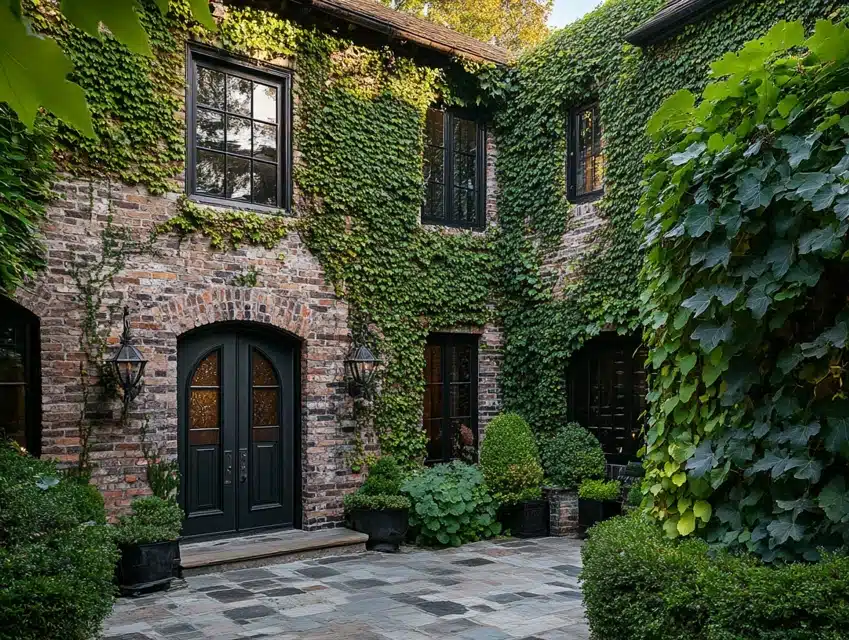
Ivy-covered walls are a quintessential element of an English garden, and I always recommend them for adding texture and timeless beauty.
There’s something magical about how ivy softens hard surfaces like stone or brick, blending them into the natural landscape.
I love how ivy thrives with minimal care, making it a low-maintenance option for vertical greenery.
Whether it’s a small garden wall or the side of a building, ivy creates a lush, romantic backdrop that elevates the entire space.
Steps to Create:
- Choose a wall with adequate sunlight or shade, depending on the ivy variety.
- Plant ivy at the base of the wall, ensuring the soil is well-draining.
- Train the vines to climb by attaching them to trellises or supports.
- Prune regularly to keep growth under control and maintain a neat appearance.
30. Seasonal Garden Containers

Seasonal garden containers are one of my favorite ways to add flexibility and color to an English garden.
Containers let you experiment with different plants and easily switch them out as the seasons change. I often use them to accent seating areas, paths, or entryways.
For spring, I recommend tulips and daffodils; summer is perfect for geraniums and petunias. In fall, mums and ornamental kale shine, while evergreens and holly are great for winter.
Using a mix of container sizes and styles adds depth and visual interest.
Steps to Create:
- Choose sturdy containers with good drainage holes.
- Fill with nutrient-rich soil and seasonal plants.
- Arrange containers in clusters for a dynamic look.
- Water regularly and fertilize to keep plants thriving.
31. Rustic Stone Edging
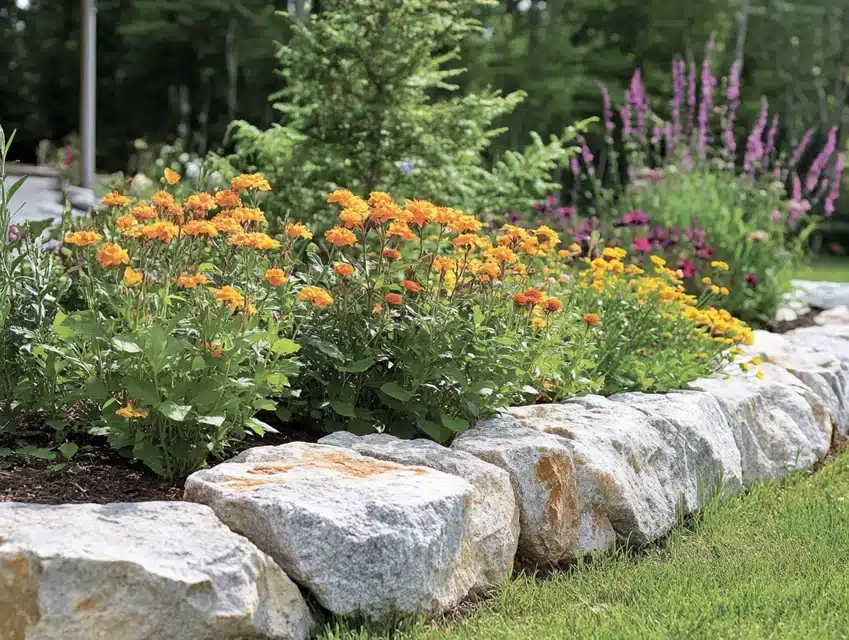
Rustic stone edging is a simple yet effective way to define flower beds and paths in an English garden.
I love how the natural texture of stone complements the softness of flowers and greenery, creating a balanced and cohesive design.
Using flat stones or small boulders, you can create organic and timeless borders. I often use stone edging to separate lawns from planting areas or to frame pathways.
It’s a practical addition that adds charm without overpowering the garden’s natural beauty.
Steps to Create:
- Map out the area where edging will be installed.
- Dig a shallow trench along the border.
- Lay stones snugly together, ensuring stability.
- Backfill with soil or gravel to secure the stones in place.
32. Butterfly Zones

Creating a butterfly zone is one of the most rewarding features of an English garden. I love watching butterflies flutter through the garden, adding movement and life to the space.
You can attract these beautiful creatures by planting nectar-rich flowers like buddleia, verbena, and zinnias.
I always include native plants to support local butterfly species and create an environment where they can thrive. Positioning the butterfly zone in a sunny, sheltered spot ensures the best results.
It’s a vibrant addition that’s both visually appealing and ecologically beneficial.
Steps to Create:
- Select a sunny location protected from strong winds.
- Plant nectar-rich flowers and native plants in clusters.
- Avoid using pesticides to keep the area safe for butterflies.
- Add a shallow water source like a birdbath for hydration.
Conclusion
Designing an English garden is about creating a space that feels like a personal retreat—a mix of beauty, peace, and timeless charm.
After working on many gardens, I’ve learned there’s no “right” way to do it.
It’s all about what makes you happy, whether rows of roses, a cozy seating nook, or winding paths lined with lavender.
The best part? English gardens are as much about enjoying the journey of creating them as they are about enjoying the finished result.
Small changes like adding flower borders or climbing plants can completely transform your space.
And remember, it doesn’t have to happen all at once. Start with a few key elements, and let your garden evolve naturally.
No matter how big or small your garden is, you’ll soon have a space that feels like your little slice of paradise.
Frequently Asked Questions
How Can I Design My English Garden?
Start by imagining the overall vibe you want—peaceful, vibrant, or a mix of both.
Focus on key features like flower borders, climbing plants, and winding pathways. Incorporate traditional elements such as roses, lavender, and boxwood hedges.
Divide your garden into sections, like seating areas or flowerbeds, and connect them with paths for a flowing layout.
What Are the Key Elements of An English Garden?
English gardens are known for their natural charm and balance of structure and wildness.
Key elements include lush flower borders, climbing plants like roses or wisteria, and gravel or stone pathways.
Which Plants Are Best Suited for An English Garden?
Traditional English gardens thrive with roses, lavender, foxgloves, and delphiniums.
Shrubs like boxwood and hydrangeas add structure, while climbers like clematis and wisteria bring height and romance.
How Can I Create an English Garden in a Small or Urban Space?
With the right touches, even a tiny space can feel like an English garden. Use vertical space by planting climbing roses or ivy on walls or trellises.
Incorporate container gardens filled with flowers like geraniums or lavender.
What Are Some Budget-Friendly Ideas for An English Garden?
Creating an English garden doesn’t have to break the bank.
Start with inexpensive plants like wildflower seeds or hardy perennials that return year after year.
Use reclaimed materials for pathways, like old bricks or gravel.
Repurpose items such as barrels or wooden crates as planters for a rustic touch.





